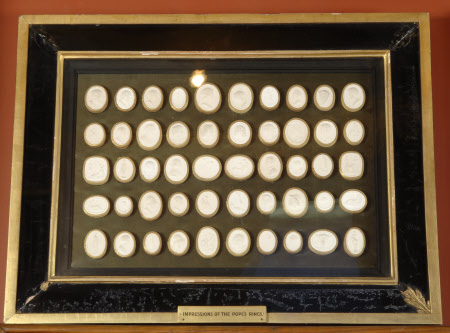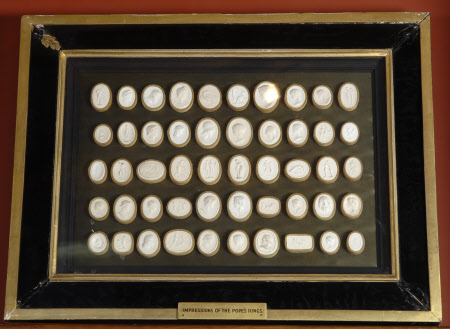One hundred impressions of gems
Nathaniel Marchant (Sussex 1739 – London 1816)
Category
Art / Sculpture
Date
c. 1792
Materials
Glass, Plaster, Wood
Place of origin
London
Order this imageCollection
Kingston Lacy Estate, Dorset
NT 1257598
Summary
Sculpture, plaster; One hundred Impressions from Gems; Nathaniel Marchant (1739-1816); 1792. Two cases containing casts in plaster of gems by Nathaniel Marchant, who was celebrated in his lifetime as an engraver of hardstone gems. One of his main specialities was the reproduction of designs after ancient Roman sculptures and gems. Marchant was a good friend of Henry Bankes, who in 1780 commissioned an intaglio seal from Marchant. In 1792, after his return from Rome to London, Marchant published a catalogue and plaster casts of 100 of his finest gems.
Full description
A framed set of one hundred plaster casts after gems by Nathaniel Marchant, in cardboard settings, set onto boards in two gilded frames. The gems are fixed to boards covered in green silk, in five rows each of ten casts. There is no thematic order to the casts. The subjects in the first case (1257598.1) include portraits of figures from mythology or classical antiquity ranging up to the Middle Ages and Renaissance, for example the poets Dante and Tasso, and even into the eighteenth century, for example Pope Pius VI (1717-1799). Other casts reproduce antiquities, such as the reclining figure often identified as Ariadne or Cleopatra, or are Neo-classical interpretations of scenes from antiquity or classical mythology. Several of the casts are signed including, fourth along in the bottom row, the cast of the double portrait of Pericles and Aspasia, taken from an engraved gem made in Rome for Henry Bankes (1757-1834) in 1780. In the second case (1257598.2), the subjects are mostly portraits of figures from mythology or classical antiquity, whilst other casts reproduce antiquities, such as the head of the Apollo Belvedere, or Cleopatra, or are Neo-classical interpretations of scenes from antiquity or classical mythology. A few of the casts are signed. The casts are within later black and gold frames, the surrounds made from glass with a black backing, now deteriorated in parts, especially towards the bottom. Gilt plaster leaves in the corners, only one partially survives on each of the frames. A label affixed to the bottom edge of both frames, ‘IMPRESSIONS OF THE POPE’S RINGS.’ On the reverses, a label for Alfred J. Mucklow, Picture Frame Maker and Dealer in Works of Art of Cranbourn Street, Leicester Square, London. Nathaniel Marchant was one of the greatest British engravers of gems. Born in Sussex, he was living in London by the early 1760s, where he was the pupil of Edward Burch (c. 1730-1814). Marchant quickly showed his talent as an engraver, winning four years running, from 1761-64, a competition in gem engraving organised by the Society of Arts. In 1772 Marchant travelled to Rome, where he lived until 1788, working as a gem-engraver but also as a small-time dealer in antiquities. Like so many other artists over the centuries, he went to Rome to study at first hand the famous sculptures of classicial antiquity. Subjects from the antique would form by far the largest part of Marchant’s work as a gem-engraver. Late in 1788 Nathaniel Marchant returned to Britain, settling in London where he would remain for the rest of his life, pursuing a moderately successful career. He was appointed 'Sculptor of Gems' to the Prince of Wales in 1789 and then, in 1799, 'Chief Engraver to His Majesty', tasked with supplying Seals of State as needed. In 1797 he became engraver at the Mint, producing a head of King George III that was used on coins from 1804; in 1800 he was appointed Engraver at the Stamp Office, engraving dies for stamp duties and taxes. Marchant exhibited at the Royal Academy until 1811 and was elected as an Associate member in 1791, but he had to wait until 1809 before being elected to full membership. During his years in Rome Marchant had found many patrons among the aristocracy and continued to take advantage of his good social connections on his return to Britain. He produced less in his later years, so it is the gems that he engraved during his years in Rome that remain his most substantial body of work. Many of these are documented through the catalogue he published in 1792, ‘A Catalogue of one hundred Impressions from Gems', that accompanied plaster sets of the gems, arranged in two hanging cases. The set remains the major source for his work. The printed text of the catalogue explained for each gem the subject, the material and dimensions, the source and the patron for whom it had been made. Many were taken from the antique, Marchant claiming in the introduction that ‘He presumes only to say for himself, that he is the first Englishman who has examined those inestimable remains of ancient art on the spot, where alone they can be studied to advantage, with a view of extending this particular branch of sculpture, and of pursuing it upon those principles before referred to, which run through all the best works of the ancients, and which an accurate observer may discover as much in the smallest of their intaglios, as in their CoIossal statues.’ (Marchant 1792, p. ii). He included a large number of ‘portraits of several great and eminent persons of antiquity, whose characters are peculiarly interesting from their connection with the history, learning, or philosophy of ancient times, and whose resemblances were, before, either totally unknown, or mistaken.’ On the other hand, although Marchant was an outstanding portraitist, the compilation has only two portraits of contemporaries, Pope Pius VI, Braschi (1717-99; Seidmann 1987, no. 148) and the Empress Catherine of Russia (1729-96; Seidmann 1987, no. 133). There were also a few casts of gems after famous paintings (e.g. Guido Reni, Fortune; Seidmann 1987, no. 117) or sculptures, notably Francesco Duquesnoy’s celebrated Saint Susanna (Seidmann 1987, no. 124), as well as images of two giants of Italian literature, Dante and the Renaissance poet Torquato Tasso (Seidmann 1987, nos. 116 and 126). Of particular interest in the context of the Bankes family and Kingston Lacy is the cast fourth from the left in the bottom row of the first case, a conjoined profile portrait of a helmeted Greek man and a woman, identified by Marchant in his catalogue as Pericles and Aspasia (Seidmann 1987, no. 95). Pericles (c. 495-429 BC) was an Athenian statesman and soldier, who as well as consolidating Athens’s position as the leading Greek city state, made the city a beacon of culture, his greatest initiative the building of the Parthenon temple. Aspasia of Miletus (c. 470 – after 428 BC) was the wife of Pericles. Marchant explained in his catalogue (Marchant 1792, no. LXVII [67]) that the portraits were based on two portrait terms excavated in 1780 and placed in the Museo Pio-Clementino in the Vatican, where they remain today. He also recorded that the original gem, in sardonyx stone, had been engraved for Henry Bankes of Kingston Lacy, who was in Rome in 1780. Bankes (1757-1834) made his Grand Tour between 1778 and 1781, visiting Rome twice. He wrote to his mother from the city on 19 August 1780 ‘I beg you to observe my Seal which is cut to great perfection by Marchant’, sealing the letter with the gem (Dorset History Centre, Bankes Archive, D-BKL/H/G/89). Bankes and Marchant evidently became close friends, their friendship continuing after the latter’s return from Rome. In his will, Nathaniel Marchant bequeathed to Henry Bankes his model of the famous antiquity known as the ‘Barberini Faun’, also requesting Bankes to assist his executors. Both ‘Henry Bankes, Esq. M.P.’ and ‘Mrs. Bankes’, presumably Henry’s mother Margaret Wynne, are recorded among the 446 subscribers to the sets of gem casts. As well the Pericles and Aspasia, Henry Bankes seems to have owned a version of another intaglio gem by Marchant, his Iphigenia (Seidmann 1987, no. 66). Neither of the original gems are in the collections at Kingston Lacy today and their location is currently unknown. The casts are sharp impressions, with every detail of the original gems beautifully reproduced. In the case of the Pericles and Aspasia, this includes the names of the subjects in Greek letters as well as Marchant’s signature MARXANT, again in Greek letters, in the field behind the head of Pericles. The plaster casts were probably made by the Scottish-born gem-engraver and modeller James Tassie (1735-1799), who in the previous year 1791 had published his own enormous catalogue of his gems. Other sets of Marchant’s Catalogue of one hundred Impressions from Gems are in the Royal Academy of Arts, London, Sir John Soane’s Museum and Stourhead (NT). The set in the RA is arranged according to the numbering in the printed catalogue, but those at Kingston Lacy and in the Soane Museum are in different orderings. The Kingston Lacy set may have been rearranged when they were remounted and reframed by the frame-maker Alfred John Mucklow (1833-1907). This must have been carried out between 1873 and 1888, since Mucklow’s label, on the back of both boxes, is in a form used by the firm during those years. It was probably at this time that the completely erroneous label ‘Impressions of the Pope’s Rings’ was affixed to both frames. At Kingston Lacy, the casts hang in the Library, above the keys of Corfe Castle, which are now on boards bearing very similar labels, suggesting that these were arranged and reframed at the same time. It is likely that the casts of Marchant’s gems were though placed in their position above the fireplace in the Library on or soon after their arrival at Kingston Lacy, as William Bankes seems to have spent much time closely studying them, to the extent that he could recall many years later the cast of the goddess Minerva, in the second row of NT 1257598.2, writing from Italy to ask his steward Seymour to send him a cast from the gem, which Bankes then gave to the sculptor Salesio Pegrassi for the image on the candelabrum dedicated to Minerva (NT 1257665.1), that stands on the left side of the door to the Saloon. Jeremy Warren October 2024
Provenance
Acquired by Henry Bankes (1757-1834) in 1792; by descent to Ralph Bankes (1902-1981); bequeathed in 1981
Marks and inscriptions
Label on frame:: IMPRESSIONS OF THE POPE’S RINGS
Makers and roles
Nathaniel Marchant (Sussex 1739 – London 1816), engraver (inciser) attributed to James Tassie (Glasgow 1735 - London 1799), caster
References
Marchant 1792: Nathaniel Marchant, A Catalogue of one hundred impressions from Gems, London 1792 Sutton 1982: Denys Sutton (ed.), Souvenirs of the Grand Tour. A Loan exhibition from National Trust Collections in Aid of the Trust’s Conservation Fund, exh. cat., Wildenstein & Co. Ltd., London 1982, no. 79, fig. 78 Seidmann 1987: Gertrud Seidmann, ‘Nathaniel Marchant, Gem-Engraver 1739-1816‘, The Walpole Society, Vol. 53 (1987), pp. 5-105

